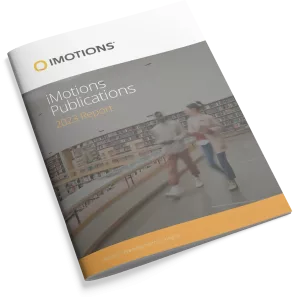-
Impact of mainstream classroom setting on attention of children with autism spectrum disorder: an eye-tracking study
It has long been reported that children with autism spectrum disorder (ASD) exhibit attention difficulties while learning. They tend to focus on irrelevant information and can easily be distracted. As a result, they are often confined to a one-to-one teaching environment, with fewer distractions and social interactions than would be present in a mainstream educational […] -
Can episodic future thinking affect food choices?
Episodic future thinking, defined as the ability to project oneself into the future, has proven useful to pre-experience the future consequences of present actions. We investigate how episodic future thinking influences the food choices of normal weight, overweight, and obese individuals. In doing so, we conduct a controlled laboratory experiment in which participants are presented […] -
Rational, emotional, and attentional models for recommender systems
This work analyses the decision‐making process underlying choice behaviour. First, neural and gaze activity were recorded experimentally from different subjects performing a choice task in a Web Interface. Second, choice models and ensembles were fitted using rational, emotional, and attentional features. The model’s predictions were evaluated in terms of their accuracy and rankings were made […] -
Rational, Emotional, and Attentional Choice Models for Recommender Systems
Abstract: This work analyzes the decision-making process underlying choice behavior. First, neural and gaze activity were recorded experimentally from different subjects performing a choice task in a Web Interface. Second, choice models were fitted using rational, emotional and attentional features. The model’s predictions were evaluated in terms of their accuracy and rankings were made for […] -
Dermal Fat Grafting to Reconstruct the Parotidectomy Defect Normalizes Facial Attention
Abstract Objectives/Hypothesis:Use validated eye‐tracking technology to objectively measure 1) the attentional distraction of facial contour defects after superficial and total parotidectomy and 2) changes in attentional distraction with abdominal dermal fat graft reconstruction. A Tobii Pro X3 eye-tracking camera system (120 Hz) and iMotions Biometric Research Platform software version 7.1.14670.18 were used to objectively measure how participants […] -
IMotions’ Automatic Facial Recognition and Text-Based Content Analysis of Basic Emotions and Empathy in the Application of the Interactive Neurocommunicative Technique LNCBT (Line and Numbered Concordant Basic Text)
This research paper focuses on the effectiveness of the Line Numbered Concordant Basic Text (LNCBT) of Narcotics Anonymous as an interactive neurocommunicative and gamificated technique to generate empathic emotions through its process and application. The LNCBT is studied as an effective educational, neurocommunicational and behavioral change technique for recovery from addictions. Firstly, it was analyzed […] -
The heterogeneous processes of cheating: Attention evidence from two eye tracking experiments
Dishonesty erodes society. Although much is known about dishonesty, the process leading up to the decision of whether to be honest or dishonest is often assumed to be homogenous and is not well understood. In this paper, we take a more nuanced approach and explore more closely the process of deciding whether to cheat or […] -
Performance Estimation using Deep Learning Based Facial Expression Analysis
Scientists now widely accept that it is important for nuclear accident analysis to consider human error in addition to the failure of safety device. Investigating human factors in nuclear accidents is a continuing concern within the field of nuclear safety and human engineering. To reduce human error and to improve human performance, there have been […] -
Facing Driver Frustration: Towards Real-Time In-Vehicle Frustration Estimation Based on Video Streams of the Face
Drivers frequently experience frustration when facing traffic jams, red lights or badly designed in-vehicle interfaces. Frustration can lead to aggressive behaviors and negative influences on user experience. Affect-aware vehicles that recognize the driver’s degree of frustration and, based on this, offer assistance to reduce the frustration or mitigate its negative effects promise remedy. As a […] -
A framework for studying design thinking through measuring designers’ minds, bodies and brains
Abstract: This paper presents a framework for studying design thinking. Three paradigmatic approaches are described to measure design cognitive processes: design cognition, design physiology and design neurocognition. Specific tools and methods serve each paradigmatic approach. Design cognition is explored through protocol analysis, black-box experiments or surveys and interviews. Design physiology is measured with eye-tracking, electrodermal […]
Research Report 2024
In-depth look at the scientific landscape as powered by iMotions software, showcasing groundbreaking research and the impact of our tools in various scientific and industrial fields.

iMotions Science Resources
Looking for white papers, validation reports or research show casing iMotions Multimodal capabilities?
Share Your Research

850+ universities worldwide with an iMotions human behavior lab
73 of the top 100 highest ranked universities
710+ published research papers using iMotions
iMotions is used for some of the most interesting human behavior research studies carried out by top researchers around the world. Contact us to have your publication featured here.
The authors of these publications have used iMotions as a software tool within their research.
“Software should be cited on the same basis as any other research product such as a paper or a book; that is, authors should cite the appropriate set of software products just as they cite the appropriate set of papers” (Katz et al., 2020).
We therefore encourage you to cite the use of iMotions where appropriate.
How to cite iMotions
APA
iMotions (10), iMotions A/S, Copenhagen, Denmark, (2024).
Note: adjust the version and year where relevant.
5 Most Popular Blogs
Learn How to Conduct Human Behavior Research with iMotions
Publications
Read publications made possible with iMotions
Blog
Get inspired and learn more from our expert content writers
Newsletter
A monthly close up of latest product and research news

